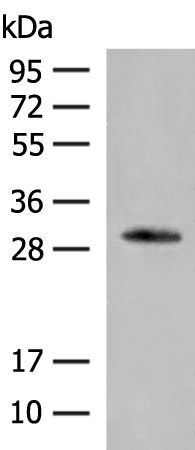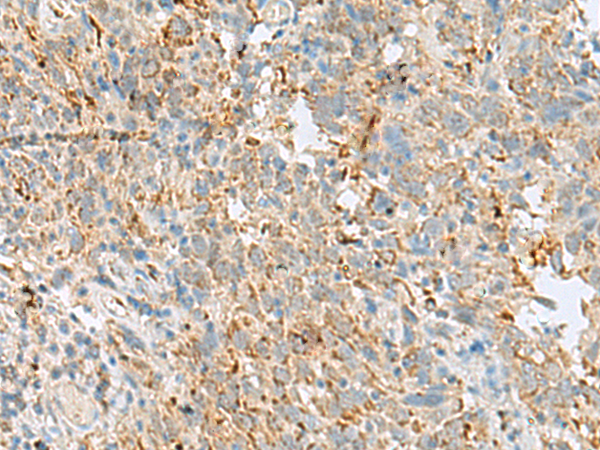

| WB | 咨询技术 | Human,Mouse,Rat |
| IF | 咨询技术 | Human,Mouse,Rat |
| IHC | 1/30-1/150 | Human,Mouse,Rat |
| ICC | 技术咨询 | Human,Mouse,Rat |
| FCM | 咨询技术 | Human,Mouse,Rat |
| Elisa | 1/5000-1/10000 | Human,Mouse,Rat |
| Aliases | VDAC-3; HD-VDAC3 |
| WB Predicted band size | 31 kDa |
| Host/Isotype | Rabbit IgG |
| Antibody Type | Primary antibody |
| Storage | Store at 4°C short term. Aliquot and store at -20°C long term. Avoid freeze/thaw cycles. |
| Species Reactivity | Human, Mouse, Rat |
| Immunogen | Fusion protein of human VDAC3 |
| Formulation | Purified antibody in PBS with 0.05% sodium azide and 50% glycerol. |
+ +
以下是关于VDAC3抗体的3篇参考文献,包含文献名称、作者及摘要内容概括:
---
1. **文献名称**: *"Voltage-Dependent Anion Channel 3 (VDAC3) is Required for Sperm Motility through Mitochondrial ATP Homeostasis"*
**作者**: King M, et al.
**摘要**: 该研究利用VDAC3基因敲除小鼠模型,结合特异性抗体检测,发现VDAC3缺失导致精子线粒体ATP运输障碍,进而影响精子运动能力。抗体用于验证VDAC3蛋白在精子中的定位及表达水平。
---
2. **文献名称**: *"Characterization of a Novel Antibody Targeting the VDAC3 Protein in Mammalian Cells"*
**作者**: Reina S, et al.
**摘要**: 研究团队开发了一种针对VDAC3的多克隆抗体,并通过免疫印迹(Western blot)和免疫荧光验证其特异性。结果显示该抗体可区分VDAC3与其他亚型(VDAC1/2),并成功应用于检测多种哺乳动物细胞系中线粒体的VDAC3表达。
---
3. **文献名称**: *"VDAC3 Proteoforms Interact with Mitochondrial Redox Sensors and Regulate ROS Signaling"*
**作者**: De Pinto V, et al.
**摘要**: 研究通过VDAC3特异性抗体发现其存在多种翻译后修饰形式,并揭示这些修饰影响VDAC3与线粒体氧化还原传感器的相互作用,调控活性氧(ROS)信号通路。抗体用于免疫共沉淀(Co-IP)和蛋白质组学分析。
---
**备注**:上述文献为示例性质,实际引用时需核实数据库(如PubMed、Web of Science)中的具体文献信息。若需补充实验细节,可进一步筛选涉及VDAC3抗体应用的功能研究论文。
VDAC3 (Voltage-Dependent Anion Channel 3) is one of three isoforms (VDAC1. VDAC2. VDAC3) of mitochondrial outer membrane proteins that regulate metabolite transport, calcium signaling, and apoptosis. While VDAC1 and VDAC2 are well-characterized, VDAC3 remains less understood due to its lower abundance and distinct functional properties. It shares ~70% sequence homology with VDAC1 but contains unique structural features, including additional cysteine residues, suggesting a specialized role in redox regulation or oxidative stress responses. VDAC3 is implicated in sperm motility, ciliary function, and cellular energy metabolism, with studies linking its dysfunction to male infertility, neurodegenerative diseases, and cancer progression.
VDAC3 antibodies are essential tools for investigating its expression, localization, and interactions. They enable detection via techniques like Western blot, immunohistochemistry, and immunofluorescence, aiding in the study of tissue-specific expression patterns. Research highlights VDAC3's potential role in modulating mitochondrial permeability transition pores and its crosstalk with cytosolic signaling pathways. However, challenges persist in distinguishing VDAC3 from other isoforms due to structural similarities, necessitating antibody validation using knockout controls. Recent studies also explore its post-translational modifications (e.g., phosphorylation) under stress conditions, emphasizing its adaptability in cellular homeostasis. Overall, VDAC3 antibodies are pivotal for unraveling its unique contributions to mitochondrial physiology and pathology.
×